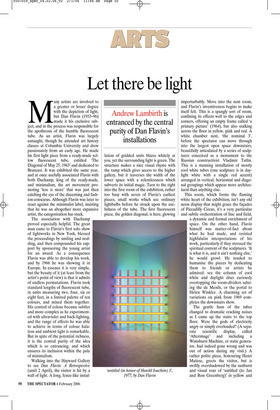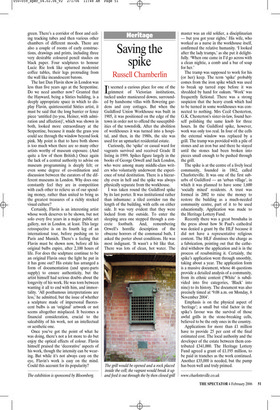Let there be light
Andrew Lambirth is entranced by the central purity of Dan Flavin’s installations
Many artists are involved to a greater or lesser degree with the depiction of light, but Dan Flavin (1933–96) made it his exclusive subject, and in the process was responsible for the apotheosis of the humble fluorescent tube. As an artist, Flavin was largely untaught, though he attended art history classes at Columbia University and drew passionately from an early age. He made his first light piece from a ready-made yellow fluorescent tube, entitled ‘The Diagonal of May 25, 1963’ and dedicated to Brancusi. It was exhibited the same year, and at once usefully associated Flavin with both Duchamp, king of the ready-made, and minimalism, the art movement promoting ‘less is more’ that was just then catching the eye of the discerning and fashion-conscious. Although Flavin was later to react against the minimalist label, insisting that he was an altogether more expansive artist, the categorisation has stuck.
The association with Duchamp proved especially helpful. The great man came to Flavin’s first solo show of lightworks in New York, blessed the proceedings by smiling and nodding, and then compounded his support by sponsoring the young artist for an award. As a consequence Flavin was able to develop his work, and by 1966 he was showing it in Europe. In essence it is very simple, but the beauty of it (at least from the artist’s point of view) is that it admits of endless permutations. Flavin took standard lengths of fluorescent tube, in units measuring two, four, six or eight feet, in a limited palette of ten colours, and mixed them together. His control of colour became subtler and more complex as he experimented with ultraviolet and back-lighting, and the range of effects he was able to achieve in terms of colour halation and ambient light is remarkable. But in spite of the potential richness, it is the central purity of the idea which is so entrancing, and which ensures its inclusion within the pale of minimalism.
Walking into the Hayward Gallery to see Dan Flavin: A Retrospective (until 2 April), the visitor is hit by a wall of light. A long, fence-like instal lation of gridded units blares whitely at you, yet the surrounding light is green. The structure makes a nice visual rhyme with the ramp which gives access to the higher gallery, but it traverses the width of the lower space with a relentlessness which subverts its initial magic. Turn to the right into the first room of the exhibition, rather too busy with seven of Flavin’s earliest pieces, small works which use ordinary lightbulbs before he struck upon the usefulness of the tube. The first fluorescent piece, the golden diagonal, is here, glowing imperturbably. Move into the next room, and Flavin’s inventiveness begins to make itself felt. This is a spangly sort of room, confining its effects well to the edges and corners, offering an empty frame called ‘a primary picture’ (1964), but also stalking across the floor in yellow, pink and red. A white chamber next, ‘the nominal 3’, before the spectator can move through into the largest open space downstairs, beautifully articulated by a series of sculptures conceived as a monument to the Russian constructivist Vladimir Tatlin. This is a stunning installation of mostly cool white tubes (one sculpture is in daylight white with a single red accent) arranged in vertical, horizontal and diagonal groupings which appear more architectural than anything else.
This room, which forms the flaming white heart of the exhibition, isn’t any old neon display that might grace the façades of Piccadilly Circus, it’s a very particular and subtle orchestration of line and field, a dynamic and formal enrichment of space. On the other hand, Flavin himself was matter-of-fact about what he had made, and resisted highfalutin interpretations of his work, particularly if they stressed the spiritual content of the sculptures. ‘It is what it is, and it ain’t nothing else,’ he would growl. He tended to humanise the pieces by dedicating them to friends or artists he admired: see the column of cool white and daylight discs curiously overtopping the room-dividers saluting the de Menils, or the portal to Helen Winkler. A charming set of variations on pink from 1969 completes the downstairs show.
The gentle hum of the tubes changed to dramatic cracking noises as I came up the stairs to the top floor. Were the gods of electricity angry or simply overloaded? (A separate scientific display, called ‘Afterimage’ and including a Wimshurst Machine, or static generator, had indeed gone wrong and was out of action during my visit.) A rather polite piece, honouring Henri Matisse, greets the visitor, but is swiftly overshadowed by the sunburst and visual roar of ‘untitled (to Jan and Ron Greenberg)’ in yellow and green. There’s a corridor of floor and ceiling tracking tubes and then various other chambers of different moods. There are also a couple of rooms of early constructions, drawings and prints, including three very desirable coloured pencil studies on black paper. Four sculptures to honour Lucie Rie look like upturned modernist coffee tables, their legs protruding from the wall like incandescent batons.
The last Dan Flavin show in London was less than five years ago at the Serpentine. Do we need another now? Granted that the Hayward, being a Sixties building, is a deeply appropriate space in which to display Flavin, quintessential Sixties artist, it must be said that the long barrier or fence piece ‘untitled (to you, Heiner, with admiration and affection)’, which was shown in both, looked more extraordinary at the Serpentine, because it made the grass you could see through the window beyond look pink. My point is that to have both shows is too much when there are so many other artists worthy of museum exposure. (And quite a few of them British.) Once again the lack of a central authority to advise on museum programming is deeply felt; or even some degree of co-ordination and discussion between the curators of the different museums in London. Why does one constantly feel they are in competition with each other to relieve us of our spending money, rather than united to bring us the greatest treasures of a richly stocked visual culture?
Certainly, Flavin is an interesting artist whose work deserves to be shown, but not solo every five years in a major public art gallery, not in London, at least. This large retrospective is on its fourth leg of an international tour, before pushing on to Paris and Munich. There’s a feeling that Flavin must be shown now, before all his original bulbs expire, after 2,100 hours of life. For does the sculpture continue to be an original Flavin once the light he put in it has gone out? His estate has arranged a form of documentation (and spare-parts supply) to ensure authenticity, but the artist himself had serious doubts about the longevity of his work. He was torn between wanting it all to end with him, and immortality. ‘All posthumous interpretations are less,’ he admitted, but the issue of whether a sculpture made of impersonal fluorescent bulbs is an ‘original’ artwork or not seems altogether misplaced. It becomes a financial consideration, crucial to the saleability of his work, not an intellectual or aesthetic one.
Once you’ve got the point of what he was doing, there’s not a lot more to do but enjoy the optical effects of colour. Flavin himself praised the ‘decorative’ aspects of his work, though the intensity can be wearing. But while it’s not always easy on the eye, Flavin’s work is easy on the mind. Could this account for its popularity?
The exhibition is sponsored by Bloomberg.






























































































































 Previous page
Previous page